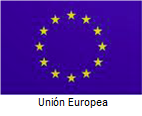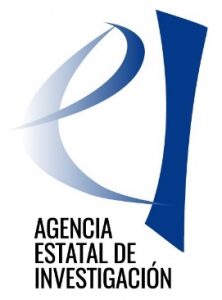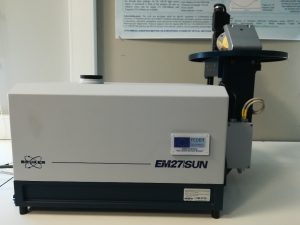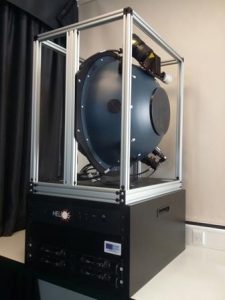Installed the scientific equipment of the R+D infrastructure project co-financed by ERDF funds
The new scientific equipment has been obtained through the project “Equipment for the Monitoring and Research on the atmospheric components that cause and modulate climate change at the Izaña GAW (Global Atmospheric Watch) (Tenerife)” (contract nº AEDM15-BE-3319), with a total monetary value of almost 410,000 euros. It has been completely installed during this April 2018 at the Izaña Observatory. This facility is managed by the Izaña Atmospheric Research Centre (IARC) of the State Meteorological Agency of Spain (AEMET).
This R+D infrastructure project has been financed by the State Research Agency of the Ministry of Economy, Industry and Competitiveness, in the Call for projects of scientific equipment, co-financed with ERDF funds.
……….. …...
…... 
 ………………..………... ……………………………………….
………………..………... ……………………………………….
The leading scientific equipment obtained by this competitive project will cause a significant improvement on the observational and research capacities of the atmosphere in the Canary Islands, and also on the atmospheric research programmes in which IARC participates. This equipment is comprised by the following devices:
1. An analyser for in situ measurements with extreme accuracy of N2O and CO molar fractions, through a Quantum Cascade Laser Spectroscopy.
This instrument is based on a spectroscopic technique with a high quality optical cavity (highreflectivity and optical quality), and low volume, that allows very large optical paths (multiple reflections inside the cavity) of infrared light (4,6 micro centimetres wavelength, approximately) that comes from a Quantum Cascade Laser with adjustable wavelength. This analyser also measures H2O, using spectral lines within the range of those that are used for N2O and CO measurements.

Spectroscopy Quantum Cascade Laser analyser for CO, N2O AND H2O, Los Gatos Research.
This equipment is now part of the GAW Greenhouse Gases and Carbon cycle project, and it is now the primary equipment for CO and N2O measurements at the Izaña Observatory. This equipment complies with the requirements of the European ICOS (Integrated Carbon Observation system) infrastructure for its measurement stations. At this moment, this equipment is the only one accepted by ICOS that is capable of measuring N2O.
2. A EM27/SUN Fourier Transform Infrared Spectrometer (FTIR) for the measurement of the O2, CO2, CH4 and H2O atmospheric columns.
This instrument registers interference or interferogram patterns associated with incident direct solar radiation. The pattern is converted by the Fourier Transform into a solar absorption spectrum with a high spectral resolution. To do so, the instrument uses a CAMTracker solar tracker that captures the incident solar beam and redirects it into a RockSolidTM Michelson interferometer. It uses an Indium Gallium Arsenide (InGaAs) detector, that is used at room temperature and it covers the near infrared spectral range between 5000 and 1000 cm-1, and also a CaF2 beam splitter, transparent in this region. This wide spectral range enables to simultaneously register the O2, CO2, CH4 and H2O absorption lines. Then, this absorption spectra are evaluated a posteriori with a radioactive model that repeatedly simulates the radioactive transference of solar irradiance into the atmosphere. This procedure obtains total concentration of these atmospheric gases in the atmospheric column.

EM27/SUN Fourier Bruker Transform Infrared Spectrometer.
This equipment will be part of the FTIR programme at IARC, complementing the high resolution FTIR (IFS 125 HR) programme which actively contributes to international networks for the measurement of atmospheric gases in the atmosphere: NDACC (Network for the Detection of Atmospheric Composition Change) and TCCON (Total Carbon Column Observing Network), since 1999 and 2007, respectively. The EM27/SUN is the only standard instrument of the recent international network COCCON (COlaborative Carbon Column Observing Network, at the Technological Institute of Karslruhe, KIT, at Germany) recommended for the operative monitoring of Greenhouse Effect gases (GEIs), which works with the consolidated TCCON. Therefore, this equipment is already used by COCCON.
In addition to that, this spectrometer will be used in the “Science- Services” MEGEI-MAD (Measurements of Emission and Concentration of Greenhouse Effect Gases at Madrid) pilot project will be held between the end of September and the beginning of October 2018. CO2 and CH4 concentrations and estimations of the corresponding emissions will be the main goal of this project.
3. Three Last Generation Multi-Band photometers for the measurement of aerosols components and optical proprieties, and to the measurement of water vapour in atmospheric columns.
These three photometers are Cimel CE318-T instruments. IARC researchers have worked in the development of the CE318-T photometer. The measurement and calibration methodology of this instrument has been developed at IARC (see Barreto et al., 2016). This equipment is now the new standard instrument of the NASA’s Aerosol Robotic Network (AERONET) (read news published 2nd October 2016 at AERONET webpage http://aeronet.gsfc.nasa.gov/ )
The CE318-T is capable of conducting day-time and night-time measurements using the sun and the moon as light sources. This enables the study of a diurnal full cycle of aerosols and water vapour on the atmosphere, which is crucail for improving atmospheric monitoring.
CE318-T has a head with a collimator with the filters and the detector, a robot with two engines for tracking both sun and moon, as well as the Principal and Almucantar planes. The electronics is kept in a weatherproof case. This instrumentation is equipped with a solar panel, a battery, a baro-transmitter to correct the pressure measurements, and a humidity sensor to automatically park the head when it rains. The equipment can be remotely controlled on Internet.

The three Cimel CE318-T photometers being calibrated with Langley technique with other Cimel Masters of AERONET-Europe (ACTRIS) at Izaña Observatory.

Electronic boxes of the three Cimel CE318-T photometers purchased in this project.
CE318-T equipment measures at 340-380-440-500-675-870-936-1020-1640 nm, wavelengths of and it does three types of measurements: direct sun (SUN mode), direct moon (MOON mode) and sky (SKY mode) in the Principal and Almucantar planes. The first two measurements determine the Aerosol Optical Depth (AOD) in the different channels. These two modes also measure column water vapour (precipitable water) with the 936nm channel. The sky measurements obtain, using an inversion model, a large number of atmospheric aerosols optical proprieties and size distribution.
The new instruments have been incorporated into the NASA’s AERONET network and in the AERONET-Europe network of the ACTRIS project, being now one of the photometers a primary reference and another one a secondary reference.
The absolute reference equipment at Izaña is exclusively dedicated to the calibration of master instruments of the Atmospheric Optics Group from University of Valladolid and the Laboratoire d’Optique Atmosphérique from the CNRS-University of Lille (LOA, France). We share with them the ACTRIS-2 AERONET-Europe management.
Apart from that, the primary reference equipment plays another crucial role: for the first time, an AERONET reference equipment is periodically calibrated and compared with the GAW-PFR (Global Atmosphere Watch- Precision Filter Radiometer) reference triad network, managed by the “Physikalisch-Meteorologisches Observatorium Davos” (PMOD) of the World Radiation Centre (WRC, Davos-Switzerland).
These instruments act as a support for the European State Agency (ESA) equipment at Teide Observatory performing moon irradiance measurements in order to develop a new model of lunar irradiance for calibration satellite atmospheric sensors calibration.
4. An integrating sphere for the laboratory radiance calibration of photometers.
It is an Ulbricht integrating 20’’ sphere with four lamps inside. It is used for conducting radiance calibrations of the CE318-T in the SKY mode. The radiance calibrations (SKY) are important to determine, by conducting atmospheric inversion modelling, aerosols optical proprieties and size distribution.

The Ulbricht 4-lamps 20’’ integrating sphere (Helios).
The integrating sphere is used in the AERONET and AERONET-Europe observation programmes. The inter-comparison among this sphere and the ones of the NASA at the Goddard Space Flight Center (Greenbelt, Maryland, EE.UU.), GOA-UVA (University of Valladolid) and LOA-Lille (University of Lille, France) will begin during 2018.
This sphere will also calibrate other radiometers and photometers that need radiance calibration.
Translated by Yaiza Aguilar, ULL trainee student; supervised by IARC staff.





